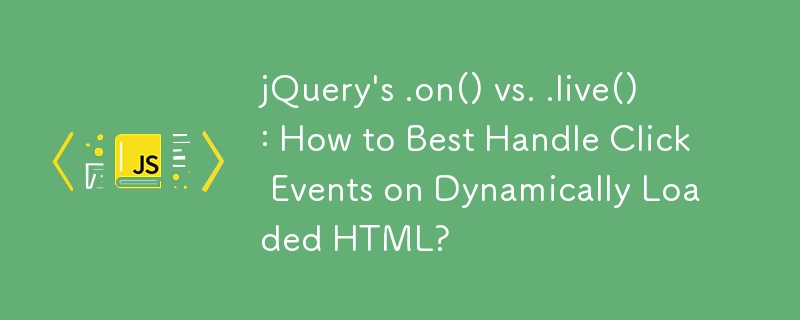Home >Web Front-end >JS Tutorial >jQuery's .on() vs. .live(): How to Best Handle Click Events on Dynamically Loaded HTML?
jQuery's .on() vs. .live(): How to Best Handle Click Events on Dynamically Loaded HTML?
- Susan SarandonOriginal
- 2024-12-21 00:52:09363browse

Attaching Click Events to Dynamically Loaded HTML: .on() vs. .live()
In the realm of JavaScript development, jQuery has established itself as a powerful tool for manipulating web content. Among its many capabilities, it allows developers to attach click events to elements using methods such as .live() and .on(). However, with the advent of jQuery versions beyond 1.7.1, the .live() method has been deprecated, leaving developers to wonder about the best alternative.
Understanding the .live() and .on() Methods
The .live() method, once a staple of jQuery, enabled developers to attach event handlers to dynamic elements that were added to the DOM after the initial page load. However, due to its drawbacks and inconsistencies, it was eventually replaced by the more versatile .on() method.
The .on() method provides a streamlined and reliable way to handle events on dynamic content. It allows for the registration of event handlers on existing as well as future elements that match a specified selector.
Dynamically Loaded HTML and Event Handling
When loading HTML content dynamically using methods like $('#element').load(), events need to be attached dynamically to ensure that newly added elements can respond to user input. Both .live() and .on() can be used for this purpose, but there's a crucial difference.
Using .live() with Dynamic Elements
While .live() was previously used for this scenario, it is no longer recommended due to its deprecation. Fortunately, .on() offers a more appropriate solution.
Correct Event Handling Using .on()
To successfully attach a click event to a dynamically loaded element using .on(), follow this approach:
- Identify the parent element that will contain the dynamic content.
- Attach the event handler to the parent element using .on():
$('#parent').on("click", "selector", function() { ... });
In this format, the "selector" parameter specifies the elements to which the event will be delegated.
Delegated Event Handling
The approach described above is known as delegated event handling. By attaching the event handler to the parent element and specifying a selector that matches the dynamically loaded element, you ensure that all future elements added to the parent element will inherit the event behavior.
Advantages of .on()
Using .on() for delegated event handling provides several advantages:
- It works with any version of jQuery.
- It ensures that events are handled even for elements that are not present in the DOM at the time the event is bound.
- It offers better performance than .live() as it reduces event bubbling and unnecessary callbacks.
Conclusion
Understanding the differences between .live() and .on() is essential for efficient event handling in jQuery. While .live() has become outdated, .on() offers a superior method for attaching events to dynamically loaded elements using delegated event handling. By adhering to this approach, developers can create responsive and dynamic web applications.
The above is the detailed content of jQuery's .on() vs. .live(): How to Best Handle Click Events on Dynamically Loaded HTML?. For more information, please follow other related articles on the PHP Chinese website!
Related articles
See more- An in-depth analysis of the Bootstrap list group component
- Detailed explanation of JavaScript function currying
- Complete example of JS password generation and strength detection (with demo source code download)
- Angularjs integrates WeChat UI (weui)
- How to quickly switch between Traditional Chinese and Simplified Chinese with JavaScript and the trick for websites to support switching between Simplified and Traditional Chinese_javascript skills

